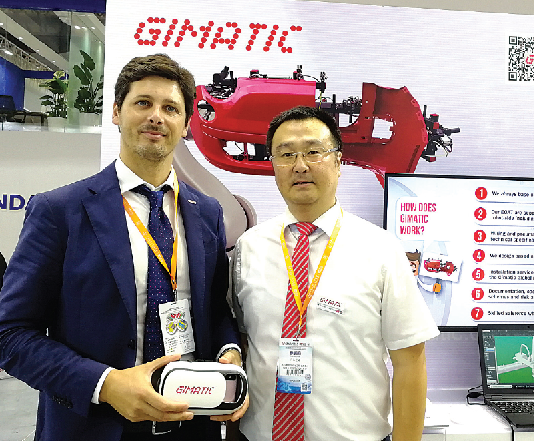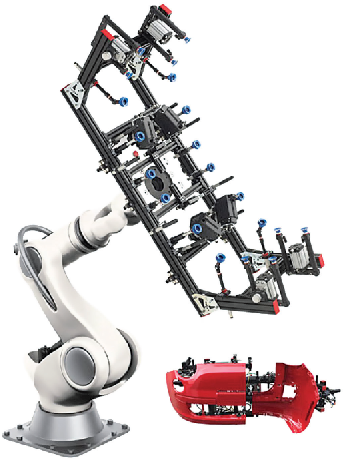
Mr. Guerino Rosso, COO of Gimatic Global (left) and Mr. Wang Feng, General Manager of Gimatic Automation Engineering (Changshu) Co., Ltd (right)
Recent developments in gripping technologies have made substantial improvement in areas where robots require greater functions. In China, the latest breed of graping systems have been aiding the whole automation process, giving manufacturers more benefits from high-performance. Italian company, Gimatic, offers automated series of standard gripping products, end-of-arm tooling (EOAT), sensors and mechanical products and services such as electromechanical integration. International Plastics News for Asia (IRNA) talks to Mr. Guerino Rosso, COO of Gimatic Global and Mr. Wang Feng, General Manager of Gimatic Automation Engineering (Changshu) Co., Ltd., on how the Group has taken a big leap to serve China and the rest of Asia.
IRNA: Please tell us about Gimatic.
Mr. Rosso: Gimatic has been an active player in the automation industry, as can be seen clearly from its new product line. We have four series, more than 3,500 products, covering all aspects in automated handling. For the Chinese market, Gimatic’s 2018 results were 50% higher than in the same period last year. Aside from the growth rate as attributed to high-quality products, Gimatic also gives credit to the rapid improvement of the Gimatic China team.
Mr. Wang: In fact, Gimatic China team really expanded only a year ago. I joined Gimatic in end of 2016 and in early 2017, I set out to distribute to the five major sales regions in China, and in one year, the headquarters of Gimatic China in Changshu was founded. And with its own sales and service offices across the country, the number of employees has grown from 4-5 to 20 now. The original Gimatic Shanghai joint venture is now a 100% wholly-owned company. Everything was going in full swing, steps are being taken methodically.
In Europe, Gimatic’s pneumatic and electric gripping components have been very stable especially in the EOAT where Gimatic has always taken the lead. Gimatic products are synonymous with top quality and ultra-high performance at rational price ratio. The gripping systems, in particular, can fully meet the requirements of short production cycle and fast picking of parts, which can greatly improve the overall efficiency of automatic production line.
With the development of trends towards Industrial 4.0 and “Made in China 2025”, China has also entered an era where it is fasttracking the development of automation solutions. The demand for enhanced stability, high positioning accuracy, easy to install set-up, intelligent and modular capture systems are rising, and these are the basis for further growth in Gimatic.
IRNA: What can you say about EOAT being an important development direction for Gimatic?
Mr. Guerino: Gimatic’s largest customers are from the automotive parts industry, and its gripping system is widely used in the production of plastic and rubber interior and exterior parts such as bumpers, doors, car seats, and central control components. Gimatic has introduced its mature plastic automation technology and solutions to China.

EOAT is an important development direction for Gimatic
Gimatic plastic series, also called “special handling”, is an automatic handling fixture, which is mainly used for the removal and handling of lightweight products such as injection moulding plastic and rubber. The series of products include suckers, nozzle clamps, telescopic rods, expansion gas clips, needle claws, profiles and so on, which is more than 2,000kinds of products. For the plastic series, and in combination or integrated with various Gimatic products, leads to the EOAT - an important offering from Gimatic.
It is understood that Gimatic’s technology and products have been fully used in plastic parts where automation or the application of robots is preferred to achieve efficiency. Gimatic EOAT can assist the robot to realise a series of actions such as sucking, clamping, holding, expanding, needling, cutting gate and so on, so as to complete the extraction, embedding and even some post-processing of injection moulded products. Because of its full range of products, strong matching capability and powerful functions, this series has consistently ranked first in our European sales for many years and in the next few years, in China and even globally. Truly, Gimatic will make EOAT its most important development direction.
Mr. Wang: EOAT is like our complex manual system, which contains a lot of sophisticated components, which is then designed into a non-standard system integration. For example, the automobile bumper, because the product is very big, there is a need to take the piece from the mould when an analysis needs to be made to each force point, which by no means any one clamp can complete.
Arguably, EOAT is a very complex gripping system that Gimatic offers for the plastics industry, and we’ve always emphasized the ability to integrate systems which is why we call Changshu an engineering company. In addition, all the components in the EOAT system are made by Gimatic.
IRNA: How is the automatic gripping system aiding the injection moulding process?
Mr. Wang: In China, the automation level of the whole plastic processingindustry is not too high and manual, semi-automated production lines are more common. In the past, manufacturers did not have too high requirements for product precision, processing efficiency, etc., as they may have to choose directly some less stable automated design schemes that would have to be adjusted every half month or a month. Now, with greater automation, processors can no longer tolerate debugging or even stopping, so more customers are starting to pursue highend EOAT, which is our market.
There is evidence in this achievement as in 2017, Gimatic China received a few sets of EOAT orders compared with several EOAT orders between June to September 2018. The steady flow of orders has put a lot of pressure on Gimatic’s design department. EOAT involves a lot of related grips,scissors, etc. Each part of the system must be positioned with great precision, otherwise it may produce waste. As a result, Gimatic designers must know many things, first robotics and automation, then mould design and the entire injection moulding process, and so on.
After obtaining the mould drawings and workpiece drawings provided by the customer, the design staff of Gimatic will examine the drawings to determine whether the information provided by the customer is adequate, and then intercept the dimensions and the corresponding parameters from the customer’s drawings. Of course, there may be several rounds of communication between them. After confirmation of the first draft of the design, we need to go through the following steps: commissioning in Changshu factory, assembling and shipping the system, and testing the mould at the customer’s office.
Each piece needs a different EOAT, and the EOAT is loaded into the robot’s wrist and needs to be fitted with the injection moulding machine and the mould to constantly adjust the configuration during the grab, which is already a system engineering.
At the CIIF booth, Gimatic showed the wonderful journey of this development and it’s an amazing sight!
No matter how different and complex the customers’ needs are, as long as they need it and demand it, automation companies, automation companies will design hundreds or even thousands of solutions according to the needs. But what is the most appropriate option? At Gimatic, we are always committed to providing customers with a better cost-effective, more stable gripping system solutions so that in the end, the customer can give a satisfied answer.
Nike














